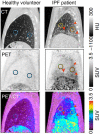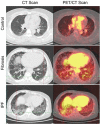Overview of positron emission tomography in functional imaging of the lungs for diffuse lung diseases
- PMID: 34752146
- PMCID: PMC9153708
- DOI: 10.1259/bjr.20210824
Overview of positron emission tomography in functional imaging of the lungs for diffuse lung diseases
Abstract
Positron emission tomography (PET) is a quantitative molecular imaging modality increasingly used to study pulmonary disease processes and drug effects on those processes. The wide range of drugs and other entities that can be radiolabeled to study molecularly targeted processes is a major strength of PET, thus providing a noninvasive approach for obtaining molecular phenotyping information. The use of PET to monitor disease progression and treatment outcomes in DLD has been limited in clinical practice, with most of such applications occurring in the context of research investigations under clinical trials. Given the high costs and failure rates for lung drug development efforts, molecular imaging lung biomarkers are needed not only to aid these efforts but also to improve clinical characterization of these diseases beyond canonical anatomic classifications based on computed tomography. The purpose of this review article is to provide an overview of PET applications in characterizing lung disease, focusing on novel tracers that are in clinical development for DLD molecular phenotyping, and briefly address considerations for accurately quantifying lung PET signals.
Figures






Similar articles
-
Molecular Imaging of Pulmonary Inflammation and Infection.Int J Mol Sci. 2020 Jan 30;21(3):894. doi: 10.3390/ijms21030894. Int J Mol Sci. 2020. PMID: 32019142 Free PMC article. Review.
-
Utility of Molecular Imaging with 2-Deoxy-2-[Fluorine-18] Fluoro-DGlucose Positron Emission Tomography (18F-FDG PET) for Small Cell Lung Cancer (SCLC): A Radiation Oncology Perspective.Curr Radiopharm. 2019;12(1):4-10. doi: 10.2174/1874471012666181120162434. Curr Radiopharm. 2019. PMID: 30465520 Review.
-
Quantification of Lung PET Images: Challenges and Opportunities.J Nucl Med. 2017 Feb;58(2):201-207. doi: 10.2967/jnumed.116.184796. Epub 2017 Jan 12. J Nucl Med. 2017. PMID: 28082432 Free PMC article. Review.
-
Non-Small-Cell Lung Cancer PET Imaging Beyond F18 Fluorodeoxyglucose.PET Clin. 2018 Jan;13(1):73-81. doi: 10.1016/j.cpet.2017.09.006. Epub 2017 Oct 23. PET Clin. 2018. PMID: 29157387 Review.
-
Molecular Imaging in Oncology Using Positron Emission Tomography.Dtsch Arztebl Int. 2018 Mar 16;115(11):175-181. doi: 10.3238/arztebl.2018.0175. Dtsch Arztebl Int. 2018. PMID: 29607803 Free PMC article. Review.
Cited by
-
Early diagnosis and staging of paraquat-induced pulmonary fibrosis using [18F]F-FAPI-42 PET/CT imaging.EJNMMI Res. 2024 Jun 18;14(1):57. doi: 10.1186/s13550-024-01118-1. EJNMMI Res. 2024. PMID: 38888802 Free PMC article.
-
Multimodal Diagnostics of Changes in Rat Lungs after Vaping.Diagnostics (Basel). 2023 Oct 30;13(21):3340. doi: 10.3390/diagnostics13213340. Diagnostics (Basel). 2023. PMID: 37958237 Free PMC article.
-
BJR functional imaging of the lung special feature: introductory editorial.Br J Radiol. 2022 Apr;95(1132):20229004. doi: 10.1259/bjr.20229004. Br J Radiol. 2022. PMID: 35312377 Free PMC article. No abstract available.
References
-
- Saha D, Takahashi K, de Prost N, Winkler T, Pinilla-Vera M, Baron RM, et al. . Micro-autoradiographic assessment of cell types contributing to 2-deoxy-2-[(18)F]fluoro-D-glucose uptake during ventilator-induced and endotoxemic lung injury. Mol Imaging Biol 2013; 15: 19–27. doi: 10.1007/s11307-012-0575-x - DOI - PMC - PubMed
Publication types
MeSH terms
Substances
LinkOut - more resources
Full Text Sources
Medical
Miscellaneous

